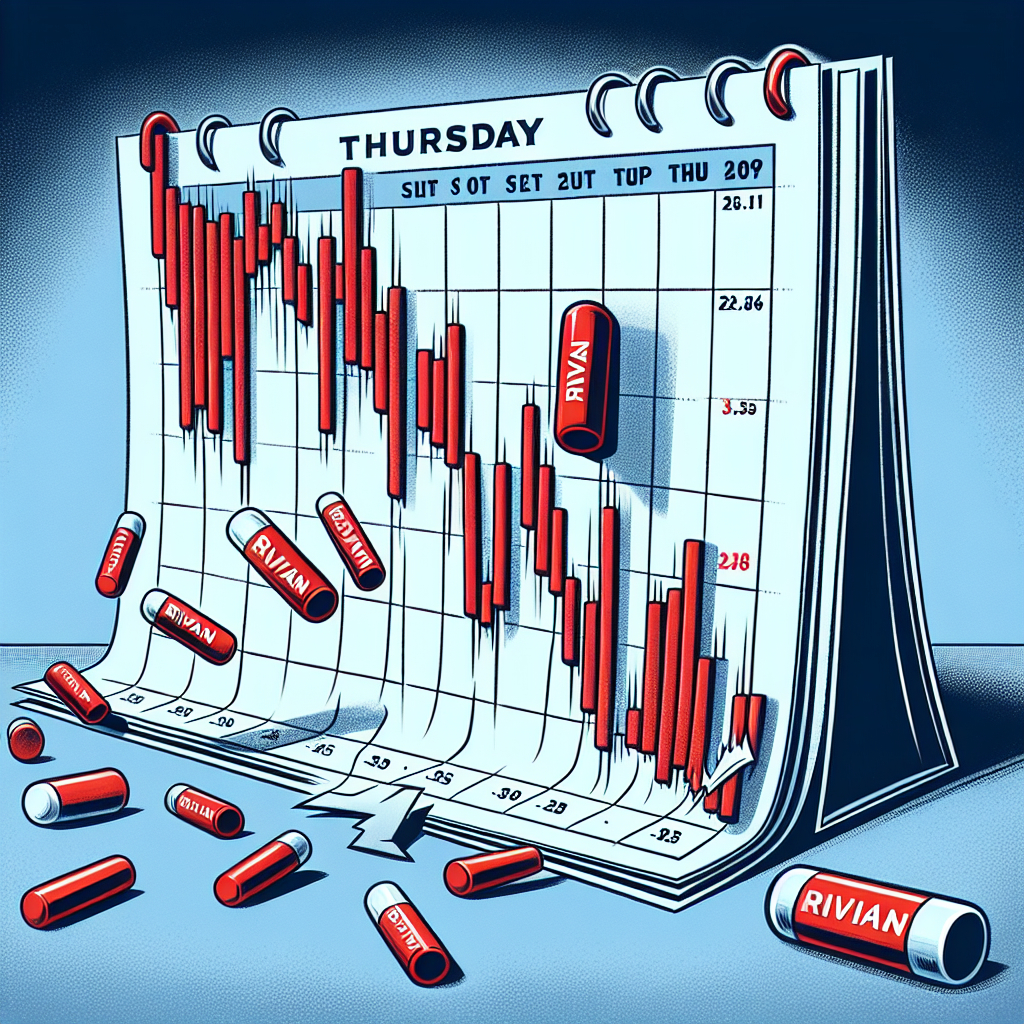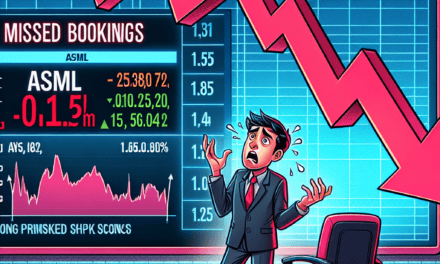“Rivian’s Rough Ride: Unpacking Thursday’s Stock Slide”
Introduction
Rivian Automotive, the electric vehicle manufacturer that has captured significant attention in the automotive and investment sectors, recently experienced a notable decline in its stock value. On Thursday, the company’s shares took a hit, reflecting a broader trend of volatility that has characterized the EV market. This drop has sparked discussions among investors and analysts, prompting a closer examination of the factors contributing to the decline. Understanding the dynamics behind Rivian’s stock movement involves analyzing market conditions, investor sentiment, and the company’s strategic positioning within the competitive landscape of electric vehicles. As Rivian navigates these challenges, stakeholders are keenly observing how the company addresses both internal and external pressures to regain investor confidence and stabilize its market performance.
Market Reactions: Analyzing Investor Sentiment on Rivian’s Stock Decline
Rivian Automotive, a prominent player in the electric vehicle (EV) market, recently experienced a notable decline in its stock value, sparking widespread discussion among investors and analysts alike. On Thursday, Rivian’s stock took a significant hit, prompting a closer examination of the factors contributing to this downturn and the broader implications for investor sentiment. Understanding the dynamics behind this decline requires an exploration of both company-specific developments and broader market conditions.
To begin with, Rivian’s stock drop can be attributed to a combination of internal challenges and external pressures. Internally, the company has faced production hurdles that have raised concerns about its ability to meet ambitious delivery targets. Despite its innovative vehicle lineup and strong initial public offering (IPO) performance, Rivian has struggled with supply chain disruptions and manufacturing bottlenecks. These issues have led to delays in vehicle deliveries, which, in turn, have dampened investor confidence. As production challenges persist, investors are increasingly wary of Rivian’s capacity to scale operations effectively and compete with established industry giants.
Moreover, the broader market environment has also played a crucial role in Rivian’s stock decline. The EV sector, while promising, is highly competitive and subject to rapid technological advancements. Rivian’s competitors, including Tesla and traditional automakers transitioning to electric models, have been aggressively expanding their market presence. This intensifying competition has heightened investor scrutiny on Rivian’s ability to differentiate itself and maintain a competitive edge. Additionally, macroeconomic factors such as rising interest rates and inflationary pressures have contributed to a more cautious investment climate, affecting high-growth sectors like electric vehicles.
In addition to these factors, investor sentiment has been influenced by recent financial disclosures and analyst reports. Rivian’s quarterly earnings report, which highlighted ongoing losses and increased expenditures, has raised concerns about the company’s financial health. While Rivian’s long-term growth potential remains attractive, the immediate financial outlook has prompted some investors to reassess their positions. Analyst downgrades and revised price targets have further fueled negative sentiment, leading to increased selling pressure on the stock.
Transitioning to the psychological aspect of market reactions, it is essential to consider how investor sentiment can amplify stock movements. In the case of Rivian, the initial stock decline may have triggered a cascade of selling as investors sought to mitigate potential losses. This phenomenon, often referred to as a “herd mentality,” can exacerbate price fluctuations and create a self-reinforcing cycle of declining stock values. As more investors react to the downward trend, the stock experiences additional pressure, further influencing market perceptions.
Despite the current challenges, it is important to recognize that Rivian’s stock decline does not necessarily reflect a fundamental flaw in the company’s business model or long-term prospects. The EV market is characterized by volatility, and short-term fluctuations are not uncommon. For investors with a long-term perspective, Rivian’s commitment to innovation and sustainability may still hold significant appeal. As the company addresses its production issues and refines its strategic approach, there is potential for a rebound in investor confidence.
In conclusion, Rivian’s stock decline on Thursday underscores the complex interplay of internal challenges, market dynamics, and investor psychology. While the immediate outlook may appear uncertain, understanding the underlying factors driving this decline provides valuable insights into the broader market reactions. As Rivian navigates these challenges, its ability to adapt and execute its vision will be crucial in shaping future investor sentiment and determining its trajectory in the competitive EV landscape.
Financial Performance: How Recent Earnings Reports Impacted Rivian’s Valuation
Rivian Automotive, a prominent player in the electric vehicle (EV) market, recently experienced a notable decline in its stock value, particularly on Thursday. This drop has sparked considerable interest and concern among investors and market analysts alike. To comprehend the factors contributing to this decline, it is essential to examine the company’s recent financial performance and earnings reports, which have played a significant role in shaping investor sentiment and, consequently, Rivian’s market valuation.
In the latest earnings report, Rivian disclosed figures that fell short of market expectations, leading to a reevaluation of its financial health and future prospects. The company’s revenue, while showing growth compared to previous quarters, did not meet the ambitious targets set by analysts. This shortfall can be attributed to several factors, including production challenges and supply chain disruptions that have plagued the automotive industry at large. These issues have hindered Rivian’s ability to scale production to meet the burgeoning demand for its innovative electric trucks and SUVs.
Moreover, Rivian’s net loss for the quarter was larger than anticipated, further exacerbating concerns about its path to profitability. While it is not uncommon for emerging companies in the EV sector to operate at a loss as they invest heavily in production capabilities and technology development, the magnitude of Rivian’s losses has raised red flags. Investors are increasingly scrutinizing the company’s cash burn rate and its ability to sustain operations without frequent capital infusions.
Adding to the complexity of Rivian’s financial landscape is the competitive pressure from both established automakers and new entrants in the EV market. Companies like Tesla, Ford, and General Motors are aggressively expanding their electric vehicle offerings, intensifying the race for market share. This heightened competition necessitates that Rivian not only accelerates its production but also differentiates its products through innovation and superior customer experience. However, achieving these objectives requires substantial investment, which could further strain the company’s financial resources.
In light of these challenges, Rivian’s management has outlined strategic initiatives aimed at stabilizing its financial performance and restoring investor confidence. These include efforts to streamline production processes, enhance supply chain resilience, and explore strategic partnerships that could provide both technological and financial synergies. While these measures are promising, their successful implementation remains to be seen and will be closely monitored by stakeholders.
Furthermore, macroeconomic factors have also played a role in Rivian’s stock decline. The broader market has been experiencing volatility due to concerns about inflation, interest rate hikes, and geopolitical tensions. These factors have led to a risk-averse sentiment among investors, prompting them to reassess their portfolios and reduce exposure to high-growth, high-risk stocks like Rivian.
In conclusion, the recent decline in Rivian’s stock value can be attributed to a confluence of internal and external factors. The company’s underwhelming earnings report, coupled with production challenges and competitive pressures, has led to a reassessment of its valuation. While Rivian is taking steps to address these issues, the path forward is fraught with challenges that require careful navigation. Investors and market observers will be keenly watching how Rivian adapts to these dynamics and whether it can deliver on its promise of revolutionizing the electric vehicle industry.
Competitive Landscape: The Role of Rivian’s Rivals in the Stock Drop
Rivian Automotive, a prominent player in the electric vehicle (EV) market, experienced a notable decline in its stock value on Thursday, a development that has captured the attention of investors and market analysts alike. To comprehend the factors contributing to this downturn, it is essential to examine the competitive landscape in which Rivian operates, particularly the influence of its rivals. The EV market is characterized by intense competition, with numerous companies vying for market share and technological supremacy. Rivian, despite its innovative approach and promising product lineup, faces formidable challenges from established automakers and emerging startups. This competitive pressure plays a significant role in shaping investor sentiment and, consequently, the company’s stock performance.
One of the primary competitors exerting pressure on Rivian is Tesla, the undisputed leader in the EV sector. Tesla’s dominance is not only reflected in its substantial market share but also in its ability to set industry standards in terms of technology, production efficiency, and brand recognition. As Tesla continues to expand its product offerings and enhance its manufacturing capabilities, Rivian is compelled to keep pace, which can strain its resources and impact investor confidence. Moreover, Tesla’s aggressive pricing strategies and global reach further complicate Rivian’s efforts to carve out a distinct niche in the market.
In addition to Tesla, traditional automakers such as Ford and General Motors are making significant strides in the EV space. These legacy companies bring decades of manufacturing experience and established customer bases, which they are leveraging to transition into the electric vehicle market. Ford, for instance, has made headlines with its electric F-150 Lightning, a direct competitor to Rivian’s R1T pickup truck. The success of such models poses a direct threat to Rivian’s market share, as consumers may opt for brands they have trusted for years. Consequently, Rivian must continuously innovate and differentiate its products to maintain its competitive edge.
Furthermore, the entry of new players into the EV market adds another layer of complexity to Rivian’s competitive landscape. Startups like Lucid Motors and Fisker are gaining traction, each offering unique value propositions that appeal to different segments of the market. These companies, often backed by substantial investments, are rapidly advancing their technological capabilities and expanding their production capacities. As a result, Rivian faces the dual challenge of competing with both established giants and agile newcomers, each vying for a slice of the burgeoning EV market.
The competitive dynamics are further intensified by the global push towards sustainability and the increasing regulatory pressures to reduce carbon emissions. Governments worldwide are implementing policies to accelerate the adoption of electric vehicles, which, while beneficial for the industry as a whole, also heightens the urgency for companies like Rivian to scale up production and meet rising demand. This urgency can lead to operational challenges and financial strain, factors that investors closely monitor when assessing a company’s stock potential.
In conclusion, Rivian’s stock decline on Thursday can be attributed, in part, to the competitive pressures exerted by its rivals in the electric vehicle market. The presence of formidable competitors like Tesla, the strategic moves of traditional automakers, and the emergence of innovative startups all contribute to a challenging environment for Rivian. As the company navigates this complex landscape, its ability to innovate, differentiate, and efficiently scale operations will be crucial in determining its future trajectory and investor confidence.
Supply Chain Challenges: Examining Production Issues Affecting Rivian

Rivian Automotive, a prominent player in the electric vehicle (EV) market, has recently experienced a notable decline in its stock value, particularly on Thursday. This drop has raised concerns among investors and industry analysts alike, prompting a closer examination of the underlying factors contributing to this downturn. One of the primary issues affecting Rivian’s stock performance is the ongoing supply chain challenges that have been plaguing the automotive industry at large. These challenges have had a significant impact on Rivian’s production capabilities, thereby influencing investor confidence and market perceptions.
To begin with, the global supply chain has been under immense pressure due to a variety of factors, including the COVID-19 pandemic, geopolitical tensions, and natural disasters. These disruptions have led to shortages of critical components, such as semiconductors, which are essential for the production of electric vehicles. Rivian, like many other automakers, has not been immune to these challenges. The scarcity of semiconductors has forced the company to adjust its production schedules, leading to delays in vehicle deliveries and a subsequent impact on revenue projections.
Moreover, Rivian’s ambitious production targets have further exacerbated these supply chain issues. The company has set high expectations for itself, aiming to establish a strong foothold in the competitive EV market. However, meeting these targets has proven to be a formidable task in the face of supply chain constraints. As a result, Rivian has had to navigate a complex landscape of supplier relationships and logistical hurdles, which has, in turn, affected its ability to scale production efficiently.
In addition to semiconductor shortages, Rivian has also faced challenges related to the procurement of other essential materials, such as batteries and raw materials like lithium and cobalt. The demand for these materials has surged as the global push for electrification intensifies, leading to increased competition among automakers. Consequently, Rivian has had to contend with rising costs and potential bottlenecks in its supply chain, further complicating its production efforts.
Furthermore, the company’s reliance on a relatively limited number of suppliers has made it vulnerable to disruptions. Any hiccup in the supply chain can have a cascading effect on production timelines and output. This vulnerability has been a point of concern for investors, who are wary of the potential for prolonged production delays and their impact on Rivian’s financial performance.
Despite these challenges, it is important to note that Rivian is actively working to mitigate the impact of supply chain disruptions. The company has been exploring strategies to diversify its supplier base and enhance its supply chain resilience. Additionally, Rivian is investing in technology and infrastructure to improve its production processes and reduce dependency on external suppliers. These efforts, while promising, will take time to yield tangible results.
In conclusion, the recent decline in Rivian’s stock can be attributed to the multifaceted supply chain challenges that have hindered its production capabilities. While the company is taking steps to address these issues, the road to recovery may be gradual. Investors and stakeholders will be closely monitoring Rivian’s progress in overcoming these obstacles and achieving its production goals. As the EV market continues to evolve, Rivian’s ability to navigate supply chain complexities will be crucial in determining its long-term success and stability in the industry.
Regulatory Environment: Understanding Policy Changes Influencing Rivian’s Market Position
Rivian Automotive, a prominent player in the electric vehicle (EV) market, recently experienced a notable decline in its stock value, particularly on Thursday. This drop has sparked discussions among investors and analysts, prompting a closer examination of the regulatory environment that may be influencing Rivian’s market position. Understanding the policy changes and regulatory shifts is crucial for comprehending the factors contributing to this decline.
To begin with, the global regulatory landscape for electric vehicles is undergoing significant transformations. Governments worldwide are increasingly focusing on environmental sustainability, leading to the implementation of stringent emissions regulations and ambitious targets for reducing carbon footprints. While these policies generally favor the growth of the EV sector, they also impose challenges for manufacturers like Rivian. For instance, compliance with evolving emissions standards requires substantial investments in research and development, which can strain financial resources and impact profitability.
Moreover, the competitive landscape within the EV industry is intensifying, with established automakers and new entrants vying for market share. This heightened competition is further compounded by regulatory policies that incentivize innovation and technological advancements. As a result, companies like Rivian must continuously innovate to maintain their competitive edge. However, the pressure to innovate can lead to increased operational costs, which may affect short-term financial performance and, consequently, stock prices.
In addition to emissions regulations, government policies related to trade and tariffs also play a pivotal role in shaping Rivian’s market position. Trade tensions and tariff impositions can disrupt supply chains and increase production costs, thereby affecting the company’s bottom line. For instance, if tariffs are imposed on key components or raw materials essential for manufacturing electric vehicles, Rivian may face increased expenses, which could contribute to a decline in stock value.
Furthermore, subsidies and incentives for electric vehicles are critical components of the regulatory environment. These financial supports are designed to encourage consumer adoption of EVs and stimulate market growth. However, changes in these policies can have a direct impact on demand for Rivian’s products. For example, if a government decides to reduce or eliminate subsidies for electric vehicles, it could lead to a decrease in consumer interest, thereby affecting Rivian’s sales and, ultimately, its stock performance.
Another aspect to consider is the regulatory scrutiny surrounding autonomous driving technologies, which are integral to Rivian’s strategic vision. As regulatory bodies work to establish safety standards and guidelines for autonomous vehicles, companies like Rivian must navigate a complex web of compliance requirements. Meeting these standards necessitates significant investments in technology and safety measures, which can influence financial outcomes and investor sentiment.
In conclusion, the decline in Rivian’s stock on Thursday can be attributed to a confluence of factors within the regulatory environment. Emissions regulations, trade policies, subsidies, and autonomous vehicle standards all play a crucial role in shaping the company’s market position. As Rivian navigates these challenges, understanding the broader regulatory context is essential for investors and stakeholders seeking to comprehend the dynamics influencing the company’s stock performance. By staying informed about policy changes and their potential impacts, stakeholders can make more informed decisions regarding their investments in Rivian and the broader electric vehicle market.
Technological Innovations: Assessing Rivian’s R&D and Its Effect on Stock Prices
Rivian Automotive, a prominent player in the electric vehicle (EV) market, has recently experienced a notable decline in its stock prices, particularly on Thursday. This drop has sparked discussions among investors and analysts, prompting a closer examination of the factors contributing to this downturn. One critical aspect to consider is Rivian’s commitment to technological innovations and how its research and development (R&D) efforts impact its stock performance.
To begin with, Rivian has positioned itself as a leader in the EV industry by focusing on cutting-edge technology and sustainable solutions. The company’s R&D initiatives are central to its strategy, as they aim to develop advanced electric vehicles that cater to both consumer and commercial markets. These efforts are crucial for maintaining a competitive edge in an industry characterized by rapid technological advancements and increasing competition. However, the substantial investments required for R&D can also pose financial challenges, potentially affecting investor confidence and, consequently, stock prices.
Moreover, Rivian’s ambitious R&D projects often involve significant upfront costs, which can strain the company’s financial resources. While these investments are essential for long-term growth and innovation, they may lead to short-term financial pressures. Investors, particularly those focused on immediate returns, may react negatively to such financial strains, contributing to fluctuations in stock prices. This dynamic was evident in Thursday’s decline, as concerns about Rivian’s financial health and the sustainability of its R&D investments may have influenced investor sentiment.
In addition to financial considerations, the success of Rivian’s R&D efforts is closely tied to its ability to bring innovative products to market. The EV industry is highly competitive, with established players and new entrants vying for market share. Rivian’s ability to differentiate itself through unique technological offerings is crucial for attracting and retaining customers. However, delays or setbacks in product development can undermine investor confidence, as they may signal potential challenges in executing the company’s strategic vision. Such concerns can lead to stock price volatility, as seen in the recent decline.
Furthermore, the broader market environment also plays a significant role in shaping Rivian’s stock performance. The EV sector is subject to various external factors, including regulatory changes, supply chain disruptions, and shifts in consumer preferences. These elements can impact Rivian’s R&D activities and, by extension, its stock prices. For instance, changes in government policies related to EV incentives or environmental regulations can influence the company’s strategic priorities and financial outlook. Investors closely monitor these developments, and any perceived risks or uncertainties can contribute to stock price fluctuations.
Despite these challenges, it is important to recognize the potential long-term benefits of Rivian’s R&D investments. By prioritizing innovation and sustainability, Rivian is well-positioned to capitalize on the growing demand for electric vehicles and related technologies. The company’s commitment to developing cutting-edge solutions can enhance its competitive advantage and drive future growth. However, achieving these outcomes requires careful management of financial resources and effective execution of strategic initiatives.
In conclusion, Rivian’s recent stock decline on Thursday underscores the complex interplay between technological innovations, R&D investments, and stock performance. While the company’s commitment to innovation is a key driver of its long-term success, it also presents challenges that can impact investor sentiment and stock prices. As Rivian continues to navigate the evolving landscape of the EV industry, its ability to balance short-term financial pressures with long-term strategic goals will be crucial in shaping its future trajectory.
Future Outlook: Long-term Implications of Thursday’s Stock Decline for Rivian
Rivian Automotive, a prominent player in the electric vehicle (EV) market, recently experienced a notable decline in its stock value, raising questions about the long-term implications for the company. On Thursday, Rivian’s stock took a significant hit, a development that has captured the attention of investors and market analysts alike. To understand the potential future outlook for Rivian, it is essential to delve into the factors contributing to this decline and consider the broader context of the EV industry.
The immediate cause of Thursday’s stock drop can be attributed to a combination of market dynamics and company-specific challenges. Rivian, like many other companies in the EV sector, is navigating a complex landscape characterized by intense competition, supply chain disruptions, and evolving consumer preferences. The company’s recent earnings report, which fell short of market expectations, further exacerbated investor concerns. This shortfall was primarily due to production bottlenecks and rising costs, which have hindered Rivian’s ability to scale its operations effectively.
Moreover, the broader economic environment has also played a role in Rivian’s stock decline. With inflationary pressures mounting and interest rates on the rise, investors are becoming increasingly cautious about high-growth stocks, particularly those in the technology and EV sectors. This shift in investor sentiment has led to a reevaluation of Rivian’s valuation, contributing to the downward pressure on its stock price.
Despite these challenges, it is important to consider the long-term prospects for Rivian. The company remains well-positioned within the EV market, which is expected to experience substantial growth in the coming years. Rivian’s focus on producing electric trucks and SUVs, segments that are gaining popularity among consumers, provides a strategic advantage. Additionally, the company’s strong financial backing and partnerships with industry giants such as Amazon and Ford offer a solid foundation for future growth.
Furthermore, Rivian’s commitment to sustainability and innovation aligns with the global shift towards cleaner energy solutions. As governments worldwide implement stricter emissions regulations and incentivize the adoption of electric vehicles, Rivian stands to benefit from these favorable policy trends. The company’s emphasis on developing advanced battery technology and expanding its charging infrastructure also positions it well to capitalize on the increasing demand for EVs.
In light of these factors, while Thursday’s stock decline may pose short-term challenges for Rivian, it does not necessarily undermine the company’s long-term potential. Investors should consider the broader trajectory of the EV market and Rivian’s strategic initiatives when evaluating the company’s future prospects. It is crucial for Rivian to address its current operational hurdles and demonstrate its ability to execute its growth plans effectively. By doing so, the company can regain investor confidence and position itself as a leader in the evolving automotive landscape.
In conclusion, while the recent decline in Rivian’s stock may raise concerns, it is essential to view this development within the context of the broader EV industry and the company’s strategic positioning. Rivian’s focus on innovation, sustainability, and strategic partnerships provides a strong foundation for future growth. As the company navigates its current challenges and capitalizes on emerging opportunities, it has the potential to deliver long-term value to its shareholders and contribute significantly to the transformation of the automotive industry.
Q&A
1. **What caused Rivian’s stock to decline on Thursday?**
Rivian’s stock decline was primarily due to concerns over production challenges and supply chain issues affecting their ability to meet delivery targets.
2. **How did the broader market impact Rivian’s stock?**
A general downturn in the stock market, particularly in the tech and automotive sectors, contributed to the decline in Rivian’s stock.
3. **Were there any specific company announcements that influenced the stock drop?**
Rivian did not release any specific announcements on Thursday, but ongoing investor concerns about their financial performance and future profitability played a role.
4. **How did analyst ratings affect Rivian’s stock performance?**
Some analysts downgraded Rivian’s stock or adjusted their price targets, citing concerns over execution risks and competitive pressures, which negatively impacted investor sentiment.
5. **What role did investor sentiment play in the stock decline?**
Negative investor sentiment, fueled by broader economic uncertainties and skepticism about Rivian’s ability to scale production, contributed to the stock’s decline.
6. **Did any external factors, such as regulatory changes, impact Rivian’s stock?**
There were no immediate regulatory changes affecting Rivian on Thursday, but ongoing discussions about electric vehicle incentives and regulations continue to influence the market.
7. **How did Rivian’s stock performance compare to its competitors on Thursday?**
Rivian’s stock decline was in line with or slightly worse than some of its competitors, as the entire electric vehicle sector faced similar pressures and market conditions.
Conclusion
Rivian’s stock decline on Thursday can be attributed to a combination of factors that have raised concerns among investors. Key issues include production challenges, supply chain disruptions, and increased competition in the electric vehicle market. Additionally, broader market volatility and investor sentiment towards growth stocks have contributed to the downward pressure on Rivian’s stock. The company’s ability to address these operational hurdles and demonstrate sustainable growth will be crucial in regaining investor confidence and stabilizing its stock performance in the future.





